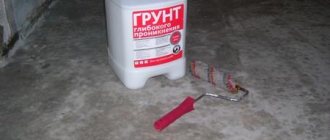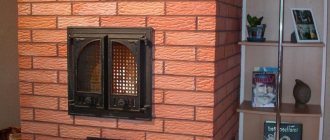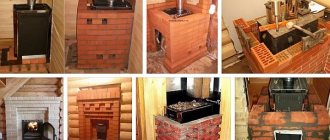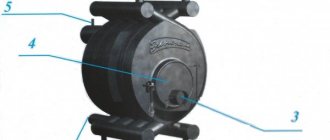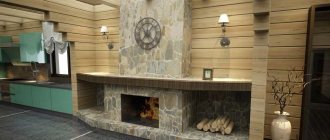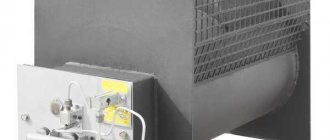An integral part of any bathhouse is the stove, which heats the bathhouse and makes the steam room comfortable and cozy. Most often, stoves are made of some kind of metal.
A metal stove is the fastest to install, it heats up quickly, has an affordable price and suitable dimensions.
But metal retains heat for only a short time and cools quickly, so you often have to add firewood. To correct this and improve the room, special sauna stoves are made to be lined with brick.
Is lining a sauna stove required?
Some people doubt whether it is necessary to cover an iron stove with bricks or not.
Experts say that lining a heating device is mandatory; thanks to the lining, the following goals are achieved:
- the bathhouse warms up evenly;
- a person is protected from burns, which can easily be caused by contact with a hot iron;
- the stove retains heat for a long time, so there is no need to add firewood often;
- the bath room becomes more attractive and decorated; you can choose any materials for lining;
- a brick-lined stove will not dry out the air; the steam room will have a humid microclimate;
- the air will become softer and more even, the heat will gradually spread throughout the steam room.
As you can see, there are many reasons why a stove in a steam room is lined with heat-resistant bricks.
Which is better to choose a stove for a sauna under brick cladding?
Manufacturers offer sauna stoves made of iron, stainless steel and cast iron. The most acceptable option is a cast iron stove, since this metal has the highest heat retention properties.
Iron or steel heats up quite quickly and quickly releases heat, so it cools down faster.
Cast iron heats up more slowly, but at the same time releases thermal energy into the bathhouse over a long period of time.
If you choose a steel stove, you will have to add firewood more often. When heated to a high temperature, steel heating devices begin to deform; this does not happen with cast iron.
After lining the stove with brick, it has to endure heating to high temperatures, and a cast-iron design is more preferable than a steel stove.
The service life of cast iron under severe temperature loads is much longer than the service life of steel.
In addition, when choosing a stove, it is important to ask the manufacturer whether it can be faced with brick, because not every product provides this possibility.
So, for a steam room, the best option is a cast iron stove, which in many respects is better than steel and stainless steel appliances.
Cast iron is capable of holding a much larger volume of heat for much longer than other types of metals.
Let's find out in more detail about the criteria for choosing a stove for a bathhouse with brick lining:
Cast iron sauna stoves with a closed heater: features
When someone is looking for a specific unit, one can assume that he is well aware of exactly where such stoves come in handy and why they are so highly valued. In fact, it may turn out that a person is simply guided by the opinion of a neighbor or friend, so we decided that a small preface would not hurt.
Russian bath conditions
Firstly, you need to understand that closed heaters are needed only in a Russian bath . Others are satisfied with open ones or they do without stones at all (hammam, for example). Why is this so important?
There is a concept of the conditions of a particular national bath. Typically it is a relationship between temperature and humidity. And also the quality of the steam.
So, the requirements of a Russian bath are simple: the room must not be too hot - no more than 60 degrees, and the humidity should be about 50 percent.
IMPORTANT! But at the same time, you need not just humidity, but a special steam - light, transparent, finely dispersed, which is obtained only from very hot stones.
Perhaps you already feel a contradiction: how to ensure that the stones overheat, but the steam room does not? The solution to this problem was brick ovens with closed heaters. The brick does not allow the air to overheat, accumulating heat from the firewood in itself, and the stones in the closed box are at this time washed by the flame, which raises their temperature to 450 degrees or more. It is enough to open the door and splash water (a separate article is devoted to stoves with a water tank) for it to evaporate instantly, reaching a temperature of more than 100 degrees.
Russian sauna stove with closed heater
But a brick stove is a troublesome task, there are few craftsmen, and there has always been a lot of metal in our country. This is how a worthy competitor to the brick stove appeared - a cast iron stove lined with brick .
By the way! For those who are not going to line the stove with bricks, but are looking for a closed heater, let us immediately say that this will not work - it is not needed if the stove gives off heat not to the brick, but to the air. In this case there will be no Russian bathhouse!
Do you want to know how to calculate the foundation for a stove and how to properly line it with bricks? Read this article.
Requirements for stoves for Russian baths
So we have come to the point that there are several interrelated requirements that units for a Russian bath must meet. There are only three requirements, but if at least one of them is not met, then it will be difficult, if not impossible, to meet the conditions.
Here they are:
- closed heater:
- a brick or stone sarcophagus with vents (a stove completely covered with brick);
- doors or dampers on the vents, with the help of which convection is regulated.
In practice, this will mean this: the casing protects the steam room from overheating while the stones inside the stove heat up to the desired temperature.
If you need to quickly catch up, the vents open . If you need to create a “steam cake” under the ceiling, the vents are closed.
In a closed heater box, the stones have no contact with air , which means they do not give off heat to it, retaining it within themselves. In an open heater you will not be able to heat the top stones to a temperature above 200 degrees .
On a note! A cast iron stove should be lined with stone or brick all the more because this metal does not particularly like strong temperature changes. The casing will protect the heated cast iron from unnecessary “stress”. By the way, this is why many manufacturers of cast iron stoves make heaters from steel - they warm up faster and do not burst from water. The best ones are stainless steel heaters . Which stoves are better for everyone to decide on their own after reading the information presented in a separate article. Some customers prefer to choose electric stoves.
Pros and cons of cast iron and closed heater
In “stove construction” only three materials are used: steel, cast iron and brick . It’s not for nothing that we placed cast iron in the middle between steel and artificial stone. Compared to steel, it has a greater heat capacity , that is, it is able to retain heat for some time, like stone. If we compare cast iron with brick, then its heat capacity will be much lower than that of the latter.
What's good and bad about heat capacity? The higher it is, the more time it takes to heat a material with such properties, but it will also take much longer to cool than a material with low heat capacity.
Therefore, to quickly heat a bathhouse, you need steel; to obtain soft, moderate heat, you need brick. Cast iron will only slightly soften the radiation - in this sense it was and remains a metal. Whether this is an advantage or a disadvantage depends on the needs of the bathhouse owner.
Closed heater on the Vesuvius stove, which is classified as inexpensive
IMPORTANT! The disadvantage of cast iron in its pure form is its fragility . He is afraid of both mechanical shocks and temperature changes. But it has increased hardness and does not deform from heat . (That’s why doors made of cast iron are better - they don’t lead).
Well, we must not forget that cast iron is cast in the form of separate parts, which are easily and simply connected during assembly. This is good because if one of them fails, then only it will need to be replaced, and not the entire stove.
Yes, and we almost forgot the most important thing: cast iron products are highly durable. Such a stove is bought to last for decades. Karelian manufacturers claim that their stove will last 30 years!
And they don't cook cast iron . If a part fails, then you can only say goodbye to it.
As for the closed heater, its advantages are obvious in a Russian bath, but special mention should be made about the disadvantages: the stones in it can be in contact with fire or be isolated from it. In the first case, the heating of the stones occurs faster and to higher temperatures, but the lifespan of the stone laying is greatly reduced. Because stones crumble from fire. They live longer in , but still less than in an open one. No other shortcomings were noticed).
What type of brick to line the stove in the bathhouse
It is important to remember that not every type of brick is suitable for lining a stove in a steam room.
The recommended option is solid, heat-resistant and fire-resistant bricks; they will not be damaged or deformed when heated to extremely high temperatures.
When selecting building materials for a stove, immediately exclude those that, according to their characteristics, are unsuitable for high heating.
Slip, silicate and raw brick are unsuitable.
The slip material will begin to crumble under the influence of regular heating, and sand-lime brick is not heat-resistant at all.
Raw brick is a hygroscopic material, so it is not suitable for wet rooms.
The best option is a special brick for stoves. It is very similar to ceramic material, but is made from selected substances and raw materials that are of high quality. The cost of kiln bricks is higher than the price of conventional ceramic materials.
Another option is to use fireclay heat-resistant material, which is used for laying stoves and fireplaces; such bricks can withstand maximum temperatures, they are fireproof and are not damaged even by very high heat.
It is not recommended to use hollow bricks, which are lighter than solid materials.
Hollow bricks heat up much faster, but at the same time they hold the temperature worse and dry out more quickly than solid bricks.
Choosing material
The stove, lined with stone or brick veneer, becomes a kind of heating chamber. The shell allows you to retain the heat coming out of the oven for a long time and evenly heat the heated room. The easiest way to cover the stove itself is to use a stone.
Refractory bricks can withstand temperatures over 1000 degrees.
This material has the following advantages:
- fire resistance
- Low cost.
- Long-term heat retention
- durability
- durability
- Infrared protection.
Fire-resistant clay bricks were chosen for masonry.
This is important: do not save when choosing bricks for the stove. It must not have defects, cracks or foreign objects. The wrong choice of material can lead to rapid wear of the cladding.
Cladding a metal sauna stove: work order
Furnace lining work includes the following:
- suitable building materials are selected; a place for the stove is prepared, the foundation is poured if necessary;
- brickwork is being done;
- the oven is decorated (if desired).
Each of the above-mentioned works is quite simple, but has certain subtleties and nuances. It is important to familiarize yourself with them before starting cladding.
Watch a video on how to line a metal stove:
Cast iron sauna stove with closed heater: manufacturers
There are several enterprises on the market specializing in the production and installation of metal stoves with a closed heater.
"Inzhkomcenter VVD"
The company produces the stoves we need under the Sudarushka and Kalita brands.
"Sudarushka"
In the first family we counted 8 types of stoves , each of which has a closed heater. The user can choose from models with meshes , steel casings and natural stone cladding.
Here, for example, is the internal structure of the Sudarushka Prima oven
Useful video
The video describes the features of the cast iron “Sudarushka”:
"Kalita"
The manufacturer’s website presents 7 varieties of “Kalita”, which have some differences: in design, size, and technical characteristics. Among them there is a bare combustion unit with a separate lining, and an option with a mesh. The remaining five are stone-lined stoves with a fairly high price.
Here's how the Kalita Russian Steam stove works:
It is worth noting that this furnace design is typical not only for Inzhkomtsentr products, but also for other manufacturers. It’s worth saying something special about her. The fact is that it is equipped with a heater, for which we could not find any other definition other than “ semi-closed ”. Manufacturers themselves sometimes call it a “ bottom heater ”. And in commercials it is often called simply “ tooth .”
It is important for us to understand whether to classify it as a closed or open variety. What distinguishes it from a closed one? Lack of tightness - it communicates freely through a fairly large hole with the upper open heater . If exactly the same stove is made in a stone lining, then a sarcophagus with doors appears above the heater. In this case, we can really say that it is “closed”.
There is another option for turning a “semi-closed” into a “closed” - this is when a steel box with doors is added. Well, or the owner independently erects a brick sarcophagus over such a unit. In any case, you need something to cover it from above. We advise you to pay attention to this point when purchasing.
Useful video
Detailed story about the Kalita stove:
"Magnum"
This is exactly the same company that sells an improved version of Kalita, because previously it supplied its fireboxes to Inzhkomtsentr. Everything that was said above about the “semi-closed” heater fully applies to the CT-1, for which Magnum became famous - and its price is lower than that of the similar “Kalita”, and the quality is higher, and they have already started cutting the stone themselves , so they now sell not only fireboxes, but also finished stoves.
This is what CT-1 looks like:
And here you can clearly see the hole in the “lower heater”:
If you take their “Russian Steam” stove, then even in the absence of diagrams you can understand that the units are different:
Russian steam stove in lining. Photo Magnum
Useful video
The manufacturer himself advertises his brainchild:
"Svarozhich"
This company was quite popular some time ago, but today they talk less about it. Below we provide a list of stoves with a closed heater and a cast iron firebox:
- Slavyanka Russian couples
- Slavyanka Lux
- Firebird Russian steam
- Firebird Lux
As you can see, it's quite short. However, variety is introduced due to the different power of the furnaces, designed for different volumes of steam rooms, and variations in stone finishing.
Here is the inside of the Slavyanka Lux stove from ]Svarozhich[/anchor].
It is quite simple - a closed, solid heater sits on a firebox , with a chimney passing through it, which also transfers some of the heat from the stove gases to the stones. convection passages inside the stove , but the heat output is regulated by a door on its lid. In addition to the firebox made of cast iron (the manufacturer admits that it is made of ordinary gray), the firebox tunnel and door are also made. This is good because steel is prone to warping.
Useful video
If interested, watch a video about the cast iron “Firebird” - one of the stoves:
"PetrozavodskMash"
This company produces Karelia brand stoves. We invite you to familiarize yourself with information about the Karelia-5 classic stove. The heaters are closed, and the user is given a choice between a solid and flow-through option. The difference between them is whether the flame is in contact with the stones or is separated from them by metal. In the first case, heating occurs faster, but the stones also crumble quickly. In addition, a stove with a continuous heater always belongs to the class of intermittent stoves, that is, the firewood (!about wood stoves here) must burn out completely before the start of the sauna procedures.
Useful video
We found a couple of interesting videos that demonstrate the design and assembly of ATB stoves:
"Hephaestus"
Finally, we will talk about the Hephaestus stoves produced by the Techno Lit company, whose designers have found a completely worthy replacement for a closed heater. They installed a very thick container in the furnace, also made of cast iron , which is washed by the flame along with the furnace gases and much faster gives the temperature necessary to create superheated water vapor. You can load a small amount of stones or cast iron cores into it. As an example, we recommend that you read the article about the Hephaestus PB-04 M ZK stove.
By the way! A cast iron insert in a heater is an old trick that speeds up heating and extends the life of the insert. Although, we must admit that it is not eternal.
Useful video
A video in which you can observe with your own eyes not only the assembly of the unit, but also the process of casting iron, and along the way learn a lot of interesting information:
*** Well, this concludes our review of stoves for Russian baths, made of cast iron and equipped with closed heaters. Good luck with your purchase and don’t forget to share your impressions in our surveys - this way you will help others make the right choice or avoid mistakes.
Pouring the foundation for the furnace
In order for the structure to be stable and durable, it is important to properly prepare the base for it.
If the existing surface is unreliable, then a foundation is poured under the stove and under its lining. Filling includes the following steps:
- the surface for the future foundation is marked;
- formwork is placed where concrete will be poured;
- the concrete composition is prepared as for pouring a regular screed;
- the base is poured and hardens.
Only when the concrete has completely set and hardened can you begin to line the stove.
Preparation of mortar for masonry
One of the important elements of masonry is the mortar.
To make the structure durable, heat-resistant and reliable, certain components are used for the solution; there are 3 main options:
- cement mixture, which is mixed with fireclay clay;
- sand-clay solution of sufficient plasticity so that cracks do not appear on it when heated;
- cement-adhesive mortar, to which a special adhesive composition for ceramic granite is added.
What tools are needed to brick a stove in a bathhouse?
In order for the brick walls to be laid according to the rules and the furnace insulation to be as effective as possible, you need to prepare the following equipment:
- tray for mixing the solution;
- galvanized buckets - 2 pcs.;
- tape measure, plumb line, level, rule;
- a hammer-pick and a hammer with a rubber nozzle for forming masonry.

